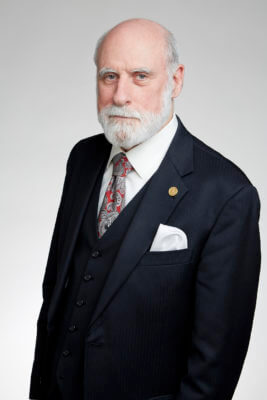Where are they now? Vint Cerf
Part 2 of a series of articles commemorating the history of internet search. Today, Vint Cerf, Vice President and Chief Internet Evangelist for Google.
To really understand how search evolved, you need to take a step back and look at how the internet emerged in the first place. To state the obvious, without the internet, search engines would be irrelevant, or at least very different from how we know them today. So where did the internet come from, and who were the key players in its development?
The list of people who contributed significantly to the development of the internet is long, but Vinton G. Cerf is universally regarded as one of the “co-fathers” of the internet.
A brief history of the internet
Up until the mid-1960s, most computers were stand-alone machines that did not connect to or communicate with other computers. In 1962, J.C.R. Licklider, a professor at MIT, wrote a paper envisioning a globally connected “Galactic Network” of computers. The idea was far-out at the time, but it caught the attention of Larry Roberts, a project manager at the US Defense Department’s Advanced Research Projects Agency (ARPA). In 1966, Roberts submitted a proposal to ARPA that would allow the agency’s numerous and disparate computers to be connected in a network similar to Licklider’s Galactic Network.
Roberts’s proposal was accepted, and work began on the ARPANET, which would in time become what we know as today’s internet. The first node on the ARPANET was installed at UCLA in 1969, and gradually, throughout the 1970s, universities and defense contractors working on ARPA projects began to connect to the ARPANET.
In 1973, the US Defense Advanced Research Projects Agency (DARPA) initiated another research program to allow networked computers to communicate transparently across multiple linked networks. Whereas the ARPANET was just one network, the new project was designed to be a network of networks. According to Vint Cerf, this was called the “Internetting project,” and the system of networks which emerged from the research was known as the “Internet.”
It wasn’t until the mid-1980s, with the simultaneous explosion in the use of personal computers and the widespread adoption of a universal standard of Internet communication called Transmission Control Protocol/Internet Protocol (TCP/IP), that the Internet became widely available to anyone desiring to connect to it. Cerf and Bob Kahn (the other “co-father” of the Internet) were the architects of this protocol.
Other government agencies fostered the growth of the Internet by contributing communications backbones that were specifically designed to carry Internet traffic. By the late 1980s, the Internet had grown from its initial network of a few computers to a robust communications network supported by governments and commercial enterprises around the world.
SMX 2009 keynote speaker

In March 2009, I had the honor of having a keynote conversation with Dr. Cerf at SMX West in Santa Clara, California. Looking back, it’s remarkable how prescient his comments were about the state of search today. At the time, the iPhone had only been on the scene for a little over 18 months, and the majority of people accessed the web via desktop computers. Nonetheless, Cerf was bullish on the future of smart mobile devices, correctly predicting that within ten years mobile would be dominant and people would increasingly be looking for answers, audio and video rather than web pages on the internet.
It was a fascinating conversation that I wished could go on for more than the hour allotted. It’s definitely worth checking out Barry Schwartz and Keri Morgret’s live coverage of the keynote conversation with Vint Cerf and Lisa Barone’s recap of the Keynote Conversation with Vint Cerf.
Vint Cerf in 2018

Cerf co-founded the “People-Centered Internet (PCI)” initiative, “created to ensure that the Internet continues to improve people’s lives and livelihoods and that the Internet is a positive force for good with helping people achieve their goals and aspirations online.”
Cerf is also active in the Interplanetary Internet project, whose mission is to realize a functional and scalable system of interplanetary data communications before the year 2020. In 2016, NASA installed Delay/Disruption Tolerant Networking (DTN) service on the International Space Station, a first step toward realizing this goal.
At age 74, the co-father of the internet shows no signs of slowing down!
Photo by Duncan.Hull — Own work, CC BY-SA 4.0, Link
The Where are they now? series
Contributing authors are invited to create content for Search Engine Land and are chosen for their expertise and contribution to the search community. Our contributors work under the oversight of the editorial staff and contributions are checked for quality and relevance to our readers. Search Engine Land is owned by Semrush. Contributor was not asked to make any direct or indirect mentions of Semrush. The opinions they express are their own.



